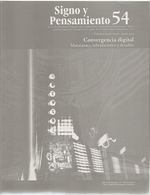Abstract
Far from working-class and peasant struggles against machines and closer to the worries and never-ending debates of the late 80’s in the 20th century, herein we focus on the microelectronic and telematic revolutions in the midst of a society that purports to seduce itself and us with the development and growth of digital technologies and intelligent devises; we find it timely to review the pros and cons of what we can call digital dualism, a state of affairs loaded with innovations, statistics, and tendencies that underwrite some sort of technological optimism. This paper raises questions and explores lines of debate which attempt to stray from the techno-phobia and/or the technophilia which has characterized so many debates on the field.
Cabello, R. (2006). Yo con la computadora nada que ver..., Buenos Aires, Prometeo-UNGS.
Cabello, R. (2008), “TIC, educación y desarrollo. El papel de la integración de los medios informáticos en la formación docente”, en: Cimadevilla, G. (comp.), Comunicación, tecnología y desarrollo. Trayectoria, unrc-alaic, Río Cuarto.
Cimadevilla, G. (2007), “Nuevos medios, legitimaciones y dominios. Algunas falacias de la sociedad de la información”, en: Boletín de la Biblioteca del Congreso de la Nación, núm. 23, Biblioteca del Congreso de la Nación, pp. 105-118.
García Canclini, N. (2004), Diferentes, desiguales y desconectados, Barcelona, Gedisa. Germani, G. (1971), Política y sociedad en una época de transición, Buenos Aires, Paidós.
Habermas, J. (1986), “La modernidad un proyecto incompleto”, en: VV. AA., La posmodernidad, Barcelona, Kairós.
Lambert, J. (1974), América Latina, Barcelona, Ariel.
Luhmann, N. (1998), Complejidad y modernidad, Madrid, Trotta. Martín Barbero, J. (2008), “Figuras del desencanto”, en: Número, núm. 36, disponible en http://www.revistanumero.com/ index.htm.
Martínez, S.; Marotias, A., y Movia, G. (2006), Internet y lucha política, los movimientos sociales en la red, Buenos Aires, Capital Intelectual.
Marx, K. (1986), El capital, México, fce. Mattelart, A. y Schmucler, H. (1983), América Latina en la encrucijada telemática, Buenos Aires, Paidós.
Monge, D. (2004), Políticas de telecomunicaciones aplicadas en la República Argentina durante la década del noventa. El caso de los centros tecnológicos comunitarios [tesis de maestría] [inédito], Córdoba, CEA-UNC
Pasquali, A. (1980), Comprender la comunicación, Caracas, Monte Ávila Editores.
Pérez, C. (1986), “Las nuevas tecnologías: una visión de conjunto”, en: Ominami, C., La tercera revolución industrial. Impactos internacionales del actual viraje tecnológico, Buenos Aires, rial.
Razo, C. (2008), “La brecha digital en América Latina” [en línea], disponible en http://www. scribd.com/doc/4024746/La-brecha-digitalen-America-Latina-2008-CEPAL, recuperado: 15 de septiembre de 2008.
Tauk Santos, S. et al. (2006), “Comunicacão e tecnología: a inclusão digital no bytes do Estacão Futuro”, en: Cimadevilla, G. (coord.), Comunicación, tecnología y desarrollo. Discusiones del siglo nuevo, Río Cuarto, UNRC-ALAIC.
PÁGINAS WEB
América Latina SI-AMSI. Disponible en http:// www.tips.org.uy/amsi/info/principal.htm. CEPAL. Disponible en: http://www.eclac.org.cepal.
“Declaración de Bávaro, Cumbre Mundial Sociedad de la Información”, disponible en: http://www.eclac.cl/prensa/noticias/ noticias/9/11719/Bavarofinalesp.pdf
Clarín (diario). Disponible en: http://www.clarin. com.ar.
Gobierno de Venezuela, Telecomunicaciones. Disponible en: http://www.cnti.gob.ve/ cnti_docmgr/noticias.html
Latinoamérica Blog. Disponible en http://www. internet-latinoamerica.blogspot.com
Javier Matuk, sitio personal. Disponible en http:// www.matuk.com.
Monitor de políticas TIC en América Latina y el Caribe. Disponible en http://www.apc.org/
John Morley (1838-1923). Disponible en: http://www.biografiasyvidas.com/biografia/m/ morley_de_blackburn.htm
Presidencia de la Nación. Programa Sociedad de la Información. Disponible en http://www. psi.gov.ar
This journal is registered under a Creative Commons Attribution 4.0 International Public License. Thus, this work may be reproduced, distributed, and publicly shared in digital format, as long as the names of the authors and Pontificia Universidad Javeriana are acknowledged. Others are allowed to quote, adapt, transform, auto-archive, republish, and create based on this material, for any purpose (even commercial ones), provided the authorship is duly acknowledged, a link to the original work is provided, and it is specified if changes have been made. Pontificia Universidad Javeriana does not hold the rights of published works and the authors are solely responsible for the contents of their works; they keep the moral, intellectual, privacy, and publicity rights.
Approving the intervention of the work (review, copy-editing, translation, layout) and the following outreach, are granted through an use license and not through an assignment of rights. This means the journal and Pontificia Universidad Javeriana cannot be held responsible for any ethical malpractice by the authors. As a consequence of the protection granted by the use license, the journal is not required to publish recantations or modify information already published, unless the errata stems from the editorial management process. Publishing contents in this journal does not generate royalties for contributors.


